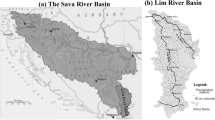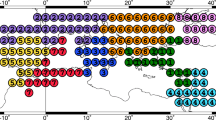Abstract
In this study, we assessed the performance of the decaying average bias correction method in removing the systematic error in daily maximum temperature (dTmax) ensemble forecasts. We applied the technique to a short-range high-resolution limited-area ensemble prediction system of the Korea Meteorological Administration, which shows under-predictive and under-dispersive characteristics for dTmax. The bias correction was applied to the grid of the model using spatial interpolation of the decaying average bias from surrounding reference points. The method was verified by evaluating the accuracy of the ensemble mean, spread-skill relationship, and the performance of the probabilistic forecasts. The results showed that the decaying average technique minimized the systematic error in the ensemble mean and improved the performance of the probabilistic forecasts. The overall mean absolute error of the ensemble mean was lowered from 2.2 to 1.2 ∘C and the root-mean-square error from 2.5 to 1.6 ∘C. The continuous ranked probability score decreased from 1.9 to 1.0 ∘C. The reliability of three dichotomous events also improved and the Brier skill scores increased. However, the bias correction only slightly affected the ensemble spread, and the system remained under-dispersive.









Similar content being viewed by others
References
Baars, J.A., Mass, C.F.: Performance of national weather service forecasts compared to operational, consensus, and weighted model output statistics. Weather Forecast. 20, 1034–1047 (2005)
Boi, P.: Probabilistic temperature forecast by using ground station measurements and ECMWF ensemble prediction system. Meteorol. Appl. 11, 301–309 (2004)
Chessa, P.A., Ficca, G., Marrocu, M., Buizza, R.: Application of a limited-area short-range ensemble forecast system to a case of heavy rainfall in the Mediterranean region. Weather Forecast. 19, 566–581 (2004)
Cui, B., Toth, Z., Zhu, Y., Hou, D.: Bias correction for global ensemble forecast. Weather Forecast. 27, 396–410 (2012)
Du, J., Zhou, B.: A dynamical performance-ranking method for predicting individual ensemble member performance and its application to ensemble averaging. Mon. Weather Rev. 139, 3284–3303 (2011)
Glahn, B., Peroutka, M., Wiedenfeld, J., Wagner, J., Zylstra, G., Schuknecht, B.: MOS uncertainty estimates in ensemble framework. Mon. Weather Rev. 137, 246–268 (2009)
Glahn, B.: Determining an optimal decay factor for bias-correcting MOS temperature and dewpoint forecasts. Weather Forecast. 29, 1076–1090 (2014)
Kalman, R.E.: A new approach to linear filtering and prediction problems. Trans. ASME J. Basic Eng. 82, 35–45 (1960)
Kim, S., Kim, H.M., Kay, J.K., Lee, S.-W.: Development and evaluation of the high resolution limited area ensemble prediction system in the Korea meteorological administration. Atmosphere. 25, 67–83 (2015)
Legg, T.P., Mylne, K.R.: Early warnings of severe weather from ensemble forecast information. Weather Forecast. 19, 891–906 (2004)
Lowe, D, Ebi, K.L., Forsberg, B.: Heatwave early warning systems and adaptation advice to reduce human health consequences of heatwaves. Int. J. Environ. Res. Public Health. 8, 4623–4648 (2011)
Lyon, B., Barnston, A.G.: Diverse characteristics of US summer heat waves. J. Clim. 30, 7827–7845 (2017)
Matsueda, M., Nakazawa, T.: Early warning products for severe weather events derived from operational medium-range ensemble forecasts. Meteorol. Appl. 22, 213–222 (2015)
Neal, R.A., Boyle, P., Grahame, N., Mylne, K., Sharpe, M.: Ensemble based first guess support towards a risk-based severe weather warning service. Meteorol. Appl. 21, 563–577 (2014)
Parker, T.J., Berry, G.J., Reeder, M.J.: The structure and evolution of heat waves in southeastern Australia. J. Clim. 27, 5768–5785 (2014)
Shepard, D.: A two-dimensional interpolation function for irregularly-spaced data. In: Proceedings of the 1968 23rd ACM National Conference, pp. 517–524. ACM (1968)
Smoyer-Tomic, K.E., Kuhn, R., Hudson, A.: Heat wave hazards: An overview of heat wave impacts in Canada. Nat. Hazards. 28, 465–486 (2003)
Tan, J., Zheng, Y., Song, G., Kalkstein, L.S., Kalkstein, A.J., Tang, X.: Heat wave impacts on mortality in Shanghai, 1998 and 2003. Int. J. Biometeorol. 51, 193–200 (2007)
Veenhuis, B.A.: Spread calibration of ensemble MOS forecasts. Mon. Weather Rev. 141, 2467–2482 (2013)
Walters, D., Brooks, M., Boutle, I., Melvin, T., Stratton, R., Vosper, S., Wells, H., Williams, K., Wood, N., Allen, T., et al: The Met office unified model global atmosphere 6.0/6.1 and JULES global land 6.0/6.1 configurations. Geosci. Model Dev. 10, 1487–1520 (2017)
Wang, J., Chen, J., Du, J., Zhang, Y., Xia, Y., Deng, G.: Sensitivity of ensemble forecast verification to model bias. Mon. Weather Rev. 146, 781–796 (2018)
Woodcock, F., Engel, C.: Operational consensus forecasts. Weather Forecast. 20, 101–111 (2005)
Yussouf, N., Stensrud, D.J.: Prediction of near-surface variables at independent locations from a bias-corrected ensemble forecasting system. Mon. Weather Rev. 134, 3415–3424 (2006)
Yussouf, N., Stensrud, D.J.: Bias-corrected short-range ensemble forecasts of near-surface variables during the 2005/06 cool season. Weather Forecast. 22, 1274–1286 (2007)
Zhu, J., Kong, F., Lei, H.: Bias-corrected short-range ensemble forecasts for near-surface variables during the summer season of 2010 in North China. Atmos. Oceanic Sci. Lett. 7, 334–339 (2014)
Acknowledgements
This work was funded by the Korea Meteorological Administration Research and Development Program “Advanced Research on Biometeorology and Industrial Meteorology” under Grant (1365003004). The authors wish to also thank Sun-il Kwon for providing guidance on LENS dataset, Dr. Ju-Young Shin for valuable comments on statistical evaluation and two anonymous reviewers for very constructive suggestions.
Author information
Authors and Affiliations
Corresponding author
Additional information
Communicated by: Seok-Woo Son
Publisher’s Note
Springer Nature remains neutral with regard to jurisdictional claims in published maps and institutional affiliations.
Rights and permissions
About this article
Cite this article
Belorid, M., Kim, K.R. & Cho, C. Bias Correction of Short-Range Ensemble Forecasts of Daily Maximum Temperature Using Decaying Average. Asia-Pacific J Atmos Sci 56, 503–514 (2020). https://doi.org/10.1007/s13143-019-00143-8
Received:
Revised:
Accepted:
Published:
Issue Date:
DOI: https://doi.org/10.1007/s13143-019-00143-8




